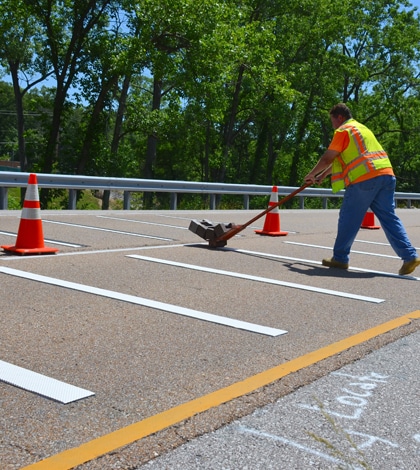New elements enhance safety on Columbia’s Route 3

On Thursday, IDOT workers install rumble strips on Route 3 to notify northbound motorists of the change in speed limit from 55 to 45 miles per hour. (Corey Saathoff photo)
Drivers along Route 3 in Columbia have noticed a host of new changes recently, all with one thing in common — getting drivers to obey traffic laws.
As the aftermath of the fatal Feb. 28 crash on Route 3 at Admiral Parkway, which claimed the life of mother-of-six Emily Webb, continues to affect drivers in Columbia, demands for change have not ebbed.
“Big pick-up truck hauling camper just blew through a red light on Route 3 at McDonald’s,” wrote one user of the Facebook group “Citizens Demanding Change on Illinois Route 3, Columbia, Illinois” last week.
Authorities are listening, as they have been since the very beginning.
Columbia Police Chief Jerry Paul has been working with the Illinois Department of Transportation, which determines all signaling, traffic control devices, speed limits and signage on the state highway.
After speaking with Columbia activists, residents, aldermen, administrators and Mayor Kevin Hutchinson, Paul created and presented to IDOT a list of proposed safety measures for the stretch of Route 3 from I-255 to Gilmore Lake Road, which is referred to as the Columbia corridor.
And IDOT listened.
The first safety measure was implemented by Paul — a full-time traffic officer assigned solely to the Columbia corridor. From May 7, his first day on the traffic detail, to May 31, he wrote 178 citations, according to Paul. Fewer than 8 percent of the drivers cited are Columbia residents.
Red light runners accounted for 75 tickets; 59 received tickets for speeding; and 25 were ticketed for no insurance, registration or valid drivers license. There were also two DUIs issued and 11 drivers ticketed for failure to wear seat belts.
“He’s primarily on patrol during rush hour Monday through Friday, but we vary that with other peak traffic times,” Paul said.
IDOT, for their part, is also getting to work on creating a safer Columbia corridor.
“IDOT has been a very good partner,” Paul said.
Last week, IDOT workers installed rumble strips in the northbound lanes of Route 3 approaching the intersection with South Main Street and in the southbound lanes of Route 3 approaching the intersection with North Main Street. The rumble strips alert drivers audibly and by causing mild vibrations that the vehicles are approaching stoplights.
In those same areas, and more, speed limit signs have been affixed with special yellow reflective strips on the poles and small yellow signs that read “NOTICE” attached to the tops of the poles above the speed limit signs, particularly in areas where the speed limit drops from 50 to 45 mph or 55 to 45 mph.
Crews have also begun work on the bump-outs just north of North Main and south of South Main. There will be others along the Columbia corridor.
“If you’re on Route 3 during rush hour in the morning and evening the traffic is very heavy,” Paul explained at an April city council meeting. “If an officer were to see somebody, for example violate a traffic light, and they stop that violator, while they’re on the side of the road, now traffic is all yielding into the far left turning lane. A lot of times this practice is more dangerous and where more accidents will occur than the (violation). So, sometimes officers will resist (pulling over violations) a little bit at those busy times”
Asphalt bump-outs provide a place officers can direct vehicles to pull over, set back from the roadway and shoulder.
“The (vehicles) are pulled out from the regular traffic and the two lanes can continue flowing,” Paul said. “The officer’s a lot safer. The violator’s a lot safer, and we don’t have those residual accidents from rubber necking — rear-end collisions and that sort of thing.”
Other safety enhancements, like paved turnarounds in the grassy medians so officers can quickly reverse direction to catch violators, as well as any potential changes to the traffic lights themselves including placement, cycle length, turn arrows and more, are longer term projects and much farther down the road.
But with the safety enhancements implemented thus far, and the quantifiable results available that they are producing results, that road should prove to be a safer one.






